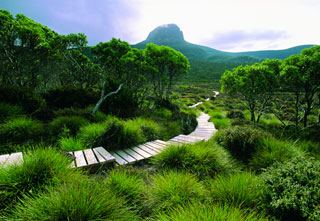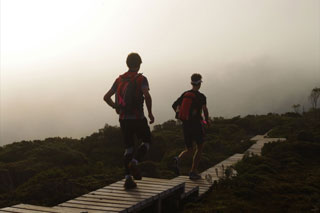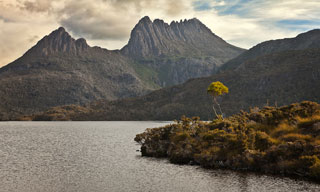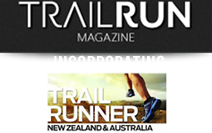The Cradle Mountain Ultra is rightly regarded as an enduring classic, having survived without razzmatazz nor huff and marketing puff for decades; in fact it has graced the Australian trail calendar for more than thirty years, eliciting a deep connection with anyone who has trodden its sometime muddy length.
WORDS: Hanny Allston
IMAGES: Bernard Walker, Greg Rubock, Nick Wienholt, Michael Slagter, Tourism Tasmania Image Library, Tegyn Angel.
Darkness hides our fears; at least I hope I am not alone in this apprehension. Head torch beams bounce through the awakening dawn. Car headlights sweep into the Waldheim car park. A slip of light filters from under the toilet door. The runner’s pack in front of me is constantly adjusted – tightened, loosened, shifted – its owner awaiting the beginning of the role call. It is race day. And the bright dawn has snuck up on us whilst we fuss.
 It is early February and our mob of forty-nine race entrants has a place in history. We are the 33rd cohort of fussing runners to pose on the tip of boardwalk snaking away from Waldheim in a southerly direction towards Lake St Clair, the deepest lake in Australia. Turning back twenty years and the synopsis still stands true.
It is early February and our mob of forty-nine race entrants has a place in history. We are the 33rd cohort of fussing runners to pose on the tip of boardwalk snaking away from Waldheim in a southerly direction towards Lake St Clair, the deepest lake in Australia. Turning back twenty years and the synopsis still stands true.
“It began in the chill half-light of a Tasmanian dawn. Forty other people will attest that we huddled on the fringe of a Myrtle rainforest, our runners’ pinks and greens and blues incongruous in that ancient landscape. A ribbon of wet boardwalk leading away across the button grass plain gave our group focus and was about to give it purpose.” – Nigel Davies, 1993.
With a maximum of fifty runners, entering the event has become somewhat of a computer game. Be seated at your computer on the count of midnight when entries open and cross your fingers and toes that you are the quickest touch-typist. A two-finger typist will join the impatient list of runners on the waiting list.
It is amazing to think of this event as being so popular when you sift back through the history books and early runners’ reports:
“The trail was mostly just bog, which seemed like fun for the first two hours or so, but after that it started to get to me, as everything, and I mean everything, was full of mud by then” – Max Bogenhuber, 1987
“Rarely does the runner see any of this. For you the primary colour is black. It is in the mud that you can’t take your eyes off, in the snakes you hope not to see. It is the colour of the leeches, of mosquitoes as large as march flies. At times it is the colour of your thoughts.” John Ayliffy, 1992,
“The race notes suggested gaiters as an option but we discovered they’re obligatory; for the button grass will tear the hairs off your legs and the mud will suck your shoes off.” – David Sill, 1992
Running along the icy boardwalks, rounding the corners gingerly in fear of upending into the button grass beds beneath me, I try not to think of how far there is to go. In shorter races it is easily possible to trick the mind into a game of ‘Just around the next corner… only a couple more hills to the finish… up and over and down the other side…’. But to think like this may leave one weeping on the trackside at Pelion Hut with the wombats and leeches singing ‘Another one stuck in the mud’.
Instead, I focus on the hill beneath me and the track winding past hanging lakes and up the sharp ridgeline towards Kitchen Hut. As I relax into the environment I find a sense of tranquility. Feet cover the ground in a mindless manner; I slot into a rhythm behind the leading males, and change the station on my mental remote control to the Sunrise Channel over Cradle Cirque.
 Despite heavy skies above, I am grateful for the relatively dry trails and the board walks protecting me from the perilous mud once recorded. I am secretly proud that I have snuck through Waterfall Valley and Waldheim huts before any of the tent’s occupants have begun their morning routines. By Pine Forest Moor a couple are traipsing along in full wet-weather gear and towering rucksacks. Not for the first time in history, I appear to be the only one smiling. As Bob Frost, stated in 1999:
Despite heavy skies above, I am grateful for the relatively dry trails and the board walks protecting me from the perilous mud once recorded. I am secretly proud that I have snuck through Waterfall Valley and Waldheim huts before any of the tent’s occupants have begun their morning routines. By Pine Forest Moor a couple are traipsing along in full wet-weather gear and towering rucksacks. Not for the first time in history, I appear to be the only one smiling. As Bob Frost, stated in 1999:
“This is a true wilderness area through mountains, marsh and thick forest. There are many lost souls along the Overland Track…”
Descending into Frog Flats at approximately 30km into the race, I am gazing into every mud puddle with trepidation. The night before my best friend and Cradle Mountain Hut’s guide, Ciara, had carefully described the large sodden mess that awaited me in the area. Each time my foot squelched and slipped into another hole I thought, “This must be the puddle she warned me about!” It was only when I found myself sucked into the middle of thick bog did I realise these were just the preludes.
“This length of trail is covered in tree roots and the rain had turned the earth to mud that I would sink ankle deep in. Some runners had talked about stepping in mud, stepping out and leaving a shoe behind. I could now appreciate what they meant. Runners passed as I slogged downhill; on my left was a steep embankment to the Forth River; on my right a steep grade upwards covered in tangled rainforest.” – Sean Greenhill, 2002.
Having survived the sucking hollows of Frog Flats, I felt like I was dancing as I skirted Pelion Plains. Out of the mist loomed Pelion West and Mt Ossa, Tasmania’s two highest peaks. My progress was slightly different to that of the early explores to the area. Exactly 57 years earlier, pioneer Keith Ernest endured a slow and painful crawl through sections of sharp, prickly Richea scoparia to summit these two mountains that dwarf the plains. He later described these as ‘The Giants of the Reserve’.
Part of the beauty of this run lies outside of the natural sights and rather with the bag of jelly lollies held out in greeting by the beaming officials on the course. Perhaps it’s the Tasmanian connection but their enthusiasm and delight at my muddy appearance was infectious. Retracing historical footsteps, I pranced away from Pelion Hut with an extra bounce and a mouth full of jubes. Some before me hadn’t felt quite so good-humored.
“There was no race organisation on this most dangerous of runs and those ‘officials’ we did meet were all afflicted with the ‘Tasmanian Disease’: they lie, they lie! ‘How far to the Gap?’… ‘About twenty minutes – and then it’s duck-board all the way’. It was an hour-twenty and then there was a kilometer of boards in thirty or so.’ – David Sill, 1992.
Passing through Kio Ora Hut I delve into the Du Cane Myrtle forests. This is my heaven and the flat, technical trails bring out the child within me. Minutes later I glimpse a flash of white through the trees, which slowly melds into the unmistakable outline of ultra sensation, Matt Cooper. Talking was unnecessary as we fall into rhythm together; his only comment being – ‘what a magical playground’. Whilst Coops came and went like a magical aura, we arrived at Narcissus together in grateful companionship and still in time for lunch.
 There is something superbly delicious about the offer of a cup of Coke when you are standing there in a stupor looking at a perfectly laid out feast. It was not until researching this article did I realize just how lucky I was to receive such a luxurious greeting from the race organisers.
There is something superbly delicious about the offer of a cup of Coke when you are standing there in a stupor looking at a perfectly laid out feast. It was not until researching this article did I realize just how lucky I was to receive such a luxurious greeting from the race organisers.
“It took us thirteen and a half hours to arrive at Narcissus, Lake St Clair, to find we’d failed to reach the cutoff point and anybody official had gone home. So we got to use the mandatory survival gear and ended up sleeping the night in a plastic bag, temperature outside 2 degrees Celsius. Meanwhile, our three wives and John’s teenage children spent restless nights haunted by their earlier experience of the Race Organiser cheerfully greeting them with the ominous news: ‘Aren’t you the wives of those three blokes from Sydney who are lost in the mountains ?’” – David Sill, 1992.
The lake. Ask any Cradle Mountain ultra runner what is the toughest section of the course and the answer is always “the lake”.
“The last bit was soul-destroying. I’m sure that everyone felt that when you get to the lake at Narcissus Hut you’ve broken the back of it and you know you’re going to finish. But it breaks your heart. It’s torture made worse by the fact that when you leave the hut there’s nearly a kilometer of duckboard but it comes to a dead-end! And then there was the darkness.” – Steve Nordish, 1992.
Perhaps it was the Coke but my recollection of this perilous section of trail is that of entertainment. The mini ups and winding downs; the curving flats and fallen trees to surmount; gob-smacked walkers darting out of your path; and finally the wide, groomed pathways of the Watersmeet where should you wish to, you can take in the botanical names of the plants you have been darting past for 82km. Unlikely!
You can almost smell the finish as you try and yet fail to run elegantly over the smoothest, flattest section of the entire race. Even had our running technique suggest class, our muddy, salt-crusted appearance was a complete giveaway of our exploits. It is with 300m to go one well-dressed teenager cruising the other way queried, “Are you in a race? How far?”… What do you say?
No matter who you are or what time you have run, by the time you reach Cynthia Bay the idea of this event being a race has long since passed. What remains is a deep sense of camaraderie – with yourself and your accomplishment, your running comrades, and the organisers themselves.
“With around 300 meters to go, I take off like a scalded cat, surprising myself how strong I feel. I cross the finish line, and Bob says ‘You made it just under 15 hours’. I say: ‘How much exactly,” and he replies: “14 hours, 59 minutes and 27 seconds”. I think that’s pretty neat.’ – John Lindsay, 2003.
Sleep is hard to come by post-race. The ache of muscles you never knew existed and a stomach sitting like a loaded barge from a sugar overload makes for a restless night. Yet despite the weariness there is a joy in crawling from under the covers, sipping tea, and then shuffling across the car park of the Derwent Tavern to mingle with runners at the presentations. Whilst winners do grin and Rob Walter and I collect our certificates, through the sharing of stories and applauding all finishers, we celebrate the accomplishment of forty-nine pairs of feet and 4018km travelled together.
How to conclude on an article delving into an event that still lives so fiercely inside me? Then an email flashes up on my screen. Distracted I absent-mindedly open it to find a new post on the Cool Running Australia blog. It reads:
“My first time for the CMR this year and it was awwwwwesome. I’ve never really run as relaxed as I did in this event: stopping to take photos and video etc. This was so special that I was often wanting to just stand still and inhale the awesome. (If it weren’t for the cut offs at Pelion and Narcissus I probably would have). HUGE thanks to all the organisers and volunteers – what an incredible event you put on. Thank you, thank you thank you!… Applause… I hope to one day return! May be see a few of you again?’ – ‘Chaneebear’, 2013.








